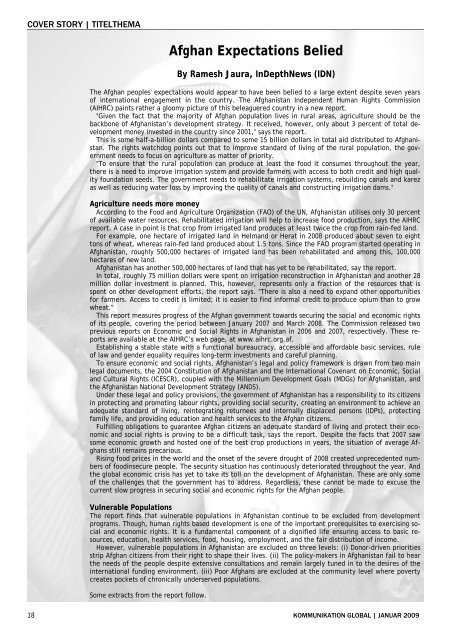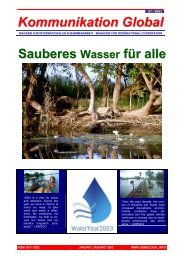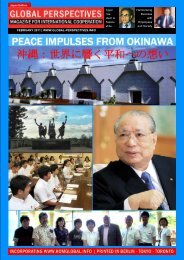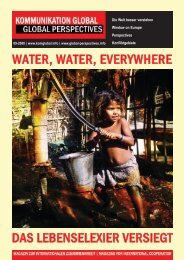GLOBAL PERSPECTIVES | KOMMUNIKATION GLOBAL - 01 | 2009
GLOBAL PERSPECTIVES | KOMMUNIKATION GLOBAL - 01 | 2009
GLOBAL PERSPECTIVES | KOMMUNIKATION GLOBAL - 01 | 2009
You also want an ePaper? Increase the reach of your titles
YUMPU automatically turns print PDFs into web optimized ePapers that Google loves.
COVER STORY | TITELTHEMA<br />
Afghan Expectations Belied<br />
By Ramesh Jaura, InDepthNews (IDN)<br />
The Afghan peoples' expectations would appear to have been belied to a large extent despite seven years<br />
of international engagement in the country. The Afghanistan Independent Human Rights Commission<br />
(AIHRC) paints rather a gloomy picture of this beleaguered country in a new report.<br />
"Given the fact that the majority of Afghan population lives in rural areas, agriculture should be the<br />
backbone of Afghanistan’s development strategy. It received, however, only about 3 percent of total development<br />
money invested in the country since 20<strong>01</strong>," says the report.<br />
This is some half-a-billion dollars compared to some 15 billion dollars in total aid distributed to Afghanistan.<br />
The rights watchdog points out that to improve standard of living of the rural population, the government<br />
needs to focus on agriculture as matter of priority.<br />
"To ensure that the rural population can produce at least the food it consumes throughout the year,<br />
there is a need to improve irrigation system and provide farmers with access to both credit and high quality<br />
foundation seeds. The government needs to rehabilitate irrigation systems, rebuilding canals and karez<br />
as well as reducing water loss by improving the quality of canals and constructing irrigation dams."<br />
Agriculture needs more money<br />
According to the Food and Agriculture Organization (FAO) of the UN, Afghanistan utilises only 30 percent<br />
of available water resources. Rehabilitated irrigation will help to increase food production, says the AIHRC<br />
report. A case in point is that crop from irrigated land produces at least twice the crop from rain-fed land.<br />
For example, one hectare of irrigated land in Helmand or Herat in 2008 produced about seven to eight<br />
tons of wheat, whereas rain-fed land produced about 1.5 tons. Since the FAO program started operating in<br />
Afghanistan, roughly 500,000 hectares of irrigated land has been rehabilitated and among this, 100,000<br />
hectares of new land.<br />
Afghanistan has another 500,000 hectares of land that has yet to be rehabilitated, say the report.<br />
In total, roughly 75 million dollars were spent on irrigation reconstruction in Afghanistan and another 28<br />
million dollar investment is planned. This, however, represents only a fraction of the resources that is<br />
spent on other development efforts, the report says. "There is also a need to expand other opportunities<br />
for farmers. Access to credit is limited; it is easier to find informal credit to produce opium than to grow<br />
wheat."<br />
This report measures progress of the Afghan government towards securing the social and economic rights<br />
of its people, covering the period between January 2007 and March 2008. The Commission released two<br />
previous reports on Economic and Social Rights in Afghanistan in 2006 and 2007, respectively. These reports<br />
are available at the AIHRC’s web page, at www.aihrc.org.af.<br />
Establishing a stable state with a functional bureaucracy, accessible and affordable basic services, rule<br />
of law and gender equality requires long-term investments and careful planning.<br />
To ensure economic and social rights, Afghanistan’s legal and policy framework is drawn from two main<br />
legal documents, the 2004 Constitution of Afghanistan and the International Covenant on Economic, Social<br />
and Cultural Rights (ICESCR), coupled with the Millennium Development Goals (MDGs) for Afghanistan, and<br />
the Afghanistan National Development Strategy (ANDS).<br />
Under these legal and policy provisions, the government of Afghanistan has a responsibility to its citizens<br />
in protecting and promoting labour rights, providing social security, creating an environment to achieve an<br />
adequate standard of living, reintegrating returnees and internally displaced persons (IDPs), protecting<br />
family life, and providing education and health services to the Afghan citizens.<br />
Fulfilling obligations to guarantee Afghan citizens an adequate standard of living and protect their economic<br />
and social rights is proving to be a difficult task, says the report. Despite the facts that 2007 saw<br />
some economic growth and hosted one of the best crop productions in years, the situation of average Afghans<br />
still remains precarious.<br />
Rising food prices in the world and the onset of the severe drought of 2008 created unprecedented numbers<br />
of foodinsecure people. The security situation has continuously deteriorated throughout the year. And<br />
the global economic crisis has yet to take its toll on the development of Afghanistan. These are only some<br />
of the challenges that the government has to address. Regardless, these cannot be made to excuse the<br />
current slow progress in securing social and economic rights for the Afghan people.<br />
Vulnerable Populations<br />
The report finds that vulnerable populations in Afghanistan continue to be excluded from development<br />
programs. Though, human rights based development is one of the important prerequisites to exercising social<br />
and economic rights. It is a fundamental component of a dignified life ensuring access to basic resources,<br />
education, health services, food, housing, employment, and the fair distribution of income.<br />
However, vulnerable populations in Afghanistan are excluded on three levels: (i) Donor-driven priorities<br />
strip Afghan citizens from their right to shape their lives. (ii) The policy-makers in Afghanistan fail to hear<br />
the needs of the people despite extensive consultations and remain largely tuned in to the desires of the<br />
international funding environment. (iii) Poor Afghans are excluded at the community level where poverty<br />
creates pockets of chronically underserved populations.<br />
Some extracts from the report follow.<br />
18 <strong>KOMMUNIKATION</strong> <strong>GLOBAL</strong> | JANUAR <strong>2009</strong>















